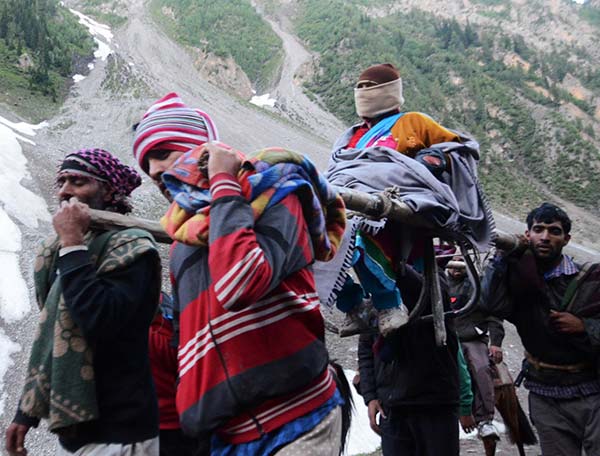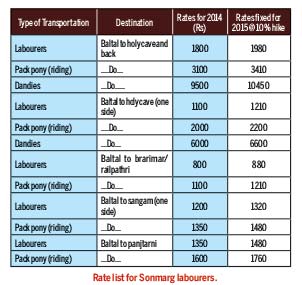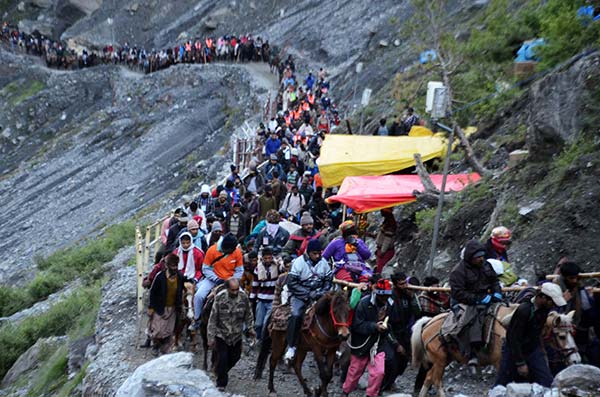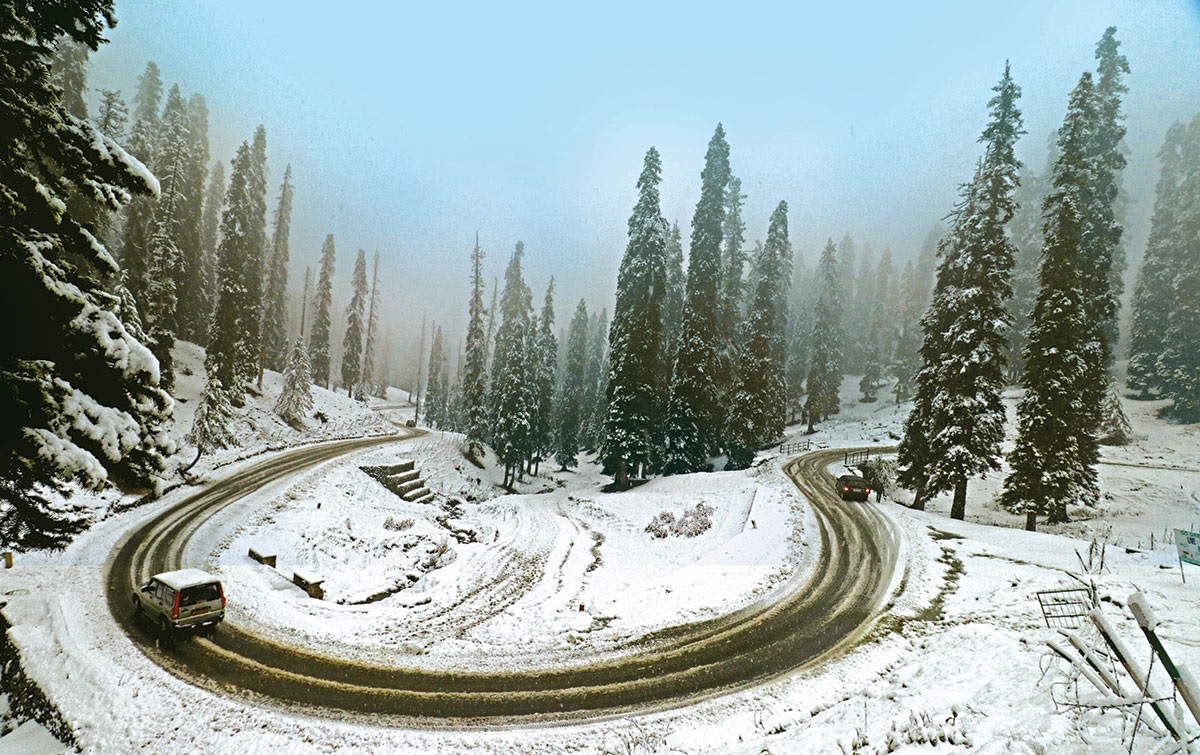At the end of every year state government and Amarnath Shrine Board thanks each other for conducting annual Amarnath Yatra successfully. But what they forget to mention is the contribution of thousands of labourers who toil through treacherous treks to help pilgrims have Darshan. Saima Bhat reports

Pahalgam in south Kashmir and Baltal in Sonmarg are busy places during hot summer months for reasons other than tourism that fuels the local economy. These twin tourist places are jam-packed with Yatris (Pilgrims) who come as part of annual Hindu yatra of Amarnath. The annual Yatra has become one of the much-debated issues in Kashmirs in last few years for its impact on the fragile ecology of the place. There were voices from different quarters, including of top environmentalists, seeking curtailment of its long duration (45 days) by half.
But till the time debate is settled a small population of labourers in both Pahalgam and Baltal are directly dependent on this annual yatra for their livelihood.
Mohammad Rafiq Bakshi, who works in Deputy Labour Commissioner’s office, says from Sonmarg route around 14,013 labourers (6045 Poniwallas, 5336 Palkiwalas, 2702 Pithuwallas), stand registered with them till July 05, 2015.
And from Pahalgam route (at Chanderwari base camp) a total of 4780 labourers (2744 Poniwallas, 575 Palkiwalas, 1461 Pituwallas) stand registered with the Labour Commissioner’s Office till July 06, 2015.
Bakshi says the number of labourers, mostly Muslims from Rajouri, Poonch, Doda, Kishtwar, Shopian, Qazigund and locals and Hindus from different parts of Jammu, are expected to increase till the end of this yatra. They are usually Gujjars who have the stamina to bear the load.
While comparing the figures with last year, he says the number of labourers from Sonmarg route was more than the Pahalgam route, as it is motorable, less risky and almost half of the Pahalgam route, which is around 37 kms.
It takes just one day to go to the cave and return on the same day from Sonmarg. But from Chanderwari side it takes yatris almost three days to reach the cave. Bakshi says that is why Yatris prefer going from Sonmarg (Baltal) when the trend was reversed just a decade back. “The Pahalgam route is now preferred for helicopter services mostly,” he says.
In 2014, around 18,114 labourers from Sonmarg route were registered with the labour office which included 6712 Poniwallas, 2700 Pithuwallas and 8702 Dandiwallas. While as from Pahalgam route, a total of 10,223 labourers were registered with this department which included 4305 Poniwallas, 4958 Pithuwallas and 960 Dandiwallas.
Every year the labour commissioner’s office issues a total of 36500 registration cards, 22500 for Baltal route and 14000 for Pahalgam route.
 And only this number of registered labourers fall under the insurance cover of Shri Amarnathji Shrine Board (SASB), says Bakshi.
And only this number of registered labourers fall under the insurance cover of Shri Amarnathji Shrine Board (SASB), says Bakshi.
This year the Yatra started on July 02 and is expected to end by August but for the people working with Labour Commissioner’s office, their Yatra duty starts much before than that in May and ends by August to make all arrangement.
But every day is a struggle for all these labourers who have to travel through the treacherous mountain trek.
Abdul Rasheed, an employee with this commission from the last 20 years, stands posted at Sonmarg camp from last 20 days. He looks tanned and his voice is not audible. “Even if our major water supply originates from Sonamarg and Pahalgam but it is not safe to drink water from here. Look at my voice. It has happened by taking that water,” he says.
His colleague adds, “When I was posted in Pahalgam, I used to call the route as Marannag because it is not less than a death trap. Horse rides on the side/ rim of those narrow roads. Just one wrong step can kill you.”
But when it comes to the labourers, they are denied the basic food facility. They claim, “We are not provided with any food or shelter from the SASB or any state-run agency. We have to make our own arrangements,” says Fayaz Ahmad, a labourer from Sheeshnag.
Besides that Fayaz claims they are not able to earn much when the same used to be their main source of livelihood. “If there is a need of 100 labourers, we have 3000. If there is a need of 4000 horses, you will find 10,000 and then the government has now started providing tents as well. You tell me what a local tent owner will earn now,” he says.
Fayaz adds, “Government has put signboards. I believe they want the local intervention should go otherwise they would have never taken such steps which will kill our source of income.”
With the discovery of technologies, this Yatra has become convenient for people who can pay for services like helicopter rides. The service was started a few years ago only, ignoring its effects on the glaciers or on the cave itself. Besides that the route from Baltal is motorable and it takes less time to reach the cave.
But when it comes to the impact on locals, they are ignored. During Yatra season, all the students in different schools in Pahalgam complaint that they are not able to study properly due to the noise created by these helicopters.
And the discovery of these new services has decreased the source of income for locals by 25 per cent, claims the officials.
Besides that Fayaz adds that a majority of their share goes to the brokers, even if the district administrations of Islamabad and Ganderbal along with tourism department have fixed their rates.
As per the district administration in Islamabad and Ganderbal, the rates for these labourers have been fixed as per the distance for all the three different types of labourers.
As per an informed source in the department, only a limited number of labourers are given passes to work during Yatra. “And they get these passes only after a number of verifications to check if they don’t have militancy links. But when it comes to the Yatris, you will find less number of registered than unregistered Yatris. There is no check on them, not even if they have any criminal backgrounds.”
Recalling his 2014 posting in Chanderwari, he says, “A labourer was beaten to a pulp for stealing a camera of a Yatri. But when we intervened we found that Yatri had kept his camera in another bag which was with another labourer. You tell me how is it possible that a labourer will steal anything from the luggage when his identity card/ his pass remains with the Yatri all along the way.”
The problem for these labourers will remain till they don’t ask for the return of their dignified living, he adds.
















